Scottish Bannocks (aka Scottish Oatcakes) are a type of unleavened oat-based flatbread made with common pantry ingredients. They have a dry earthy oat flavor with a softer texture than a cracker (but they aren't bendy either). Serve these Highland oatcakes with sweet or savory toppings for breakfast or as a snack!

Jump to:
[August, 2022: I've reworked the recipe and updated this post with all new pictures. Enjoy!]
Why this recipe works
- Bannocks are easy to make using common pantry ingredients
- Can be made using sourdough starter discard
- These oatcakes can be served with sweet or savory toppings for breakfast or as a snack
Longtime readers know that I'm a huge fan of Outlander, both the TV series on STARZ and the book series by Diana Gabaldon. Set in Scotland and America in the 18th and 20th centuries, the cuisine of the locales and time periods has provided me with many opportunities to discover new recipes to try.
Scottish bannocks are one such item that's new to me. Before discovering the Outlander series on STARZ, I had never heard of them, but they're mentioned many times in the Outlander books. I went down a rabbit hole to find out more about them.
There are many opinions on what are bannocks - some say bannocks contain oats (hence the name oatcakes), while others do not. I looked at many different recipes for bannocks, and they vary across the board in taste and texture.
The recipe I settled on do contain oats, and have a softer texture than a cracker, but aren't bendy. I like the dry earthy oat flavor that's contrasted by the melted butter. The sourdough version has a slight sourdough tang under it all.
You can enjoy bannocks with sweet toppings like butter and jam, or savory toppings like blue cheese and smoked salmon. I like to eat them for breakfast with eggs, but they're also nice for an afternoon snack.
Discovering Outlander has led me down many paths, and the culinary dishes I encounter because of it are so fun. I love making bannocks (along with Scottish shortbread, Cranachan (a raspberry & oat trifle made with scotch), and Cream Buns). What a wonderful culinary journey!
⭐⭐⭐⭐⭐
Great easy recipe. I blitzed up some instant oats to make it a fine meal, rather than the whole rolled oats. They are a dry cracker great for soft cheeses. Thanks for sharing.
- Whatswhatlife
What are bannocks?
Bannocks are a type of unleavened oat-based flatbread, cooked on a griddle (girdle, in Scotland) or baked in the oven. They are said to have originated in Scotland, but the First Nations in Canada also lay claim to them, the main difference being the type of grain flour used (wheat or corn).
Even Native Americans have their version of unleavened bread, Indian Fry bread, that's deep fried rather than baked. It's interesting to me how many cultures have the same type of bread, just different based on local grains.
I grew up eating pita and tortillas; later I discovered naan, roti, lavash and the like; and my girls baked Indian Fry bread at school. These are all examples of regional native flat breads that developed separately but with a common purpose.
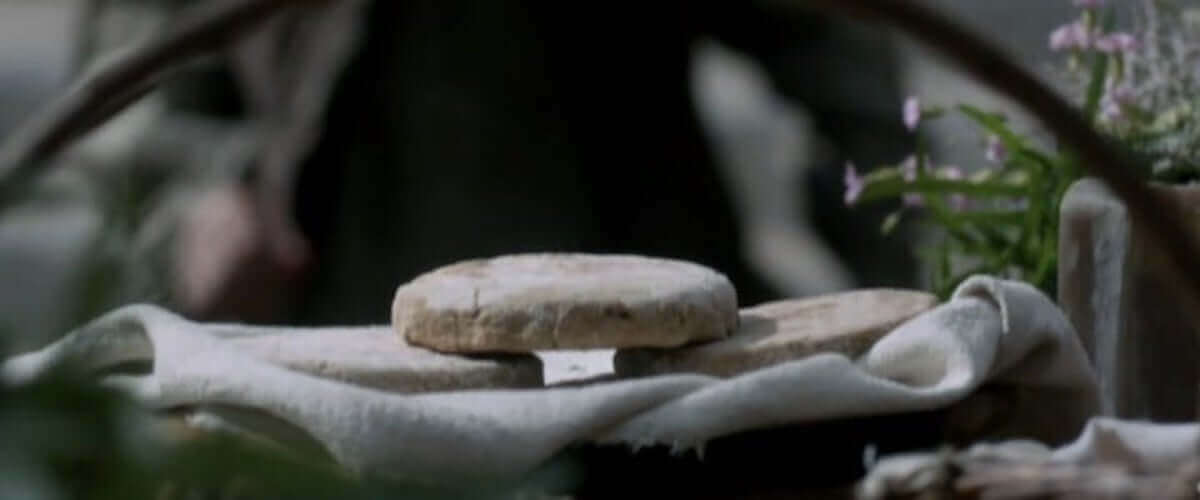
Recipe Ingredients
You'll need the following ingredients to make this Scottish bannock recipe:

Ingredient Notes
The ingredients for a bannock recipe aren't fancy, as one would expect: flour, baking powder, salt, butter, and water.
Rolled oats: As these are Scottish oatcakes, you'd expect...well...oatmeal. However, there is a difference in the definition of oatmeal based on which side of the Pond you're on. For our purposes, I'm using rolled outs.
Sourdough starter: If you want, you can use your unfed sourdough starter to make sourdough bannocks. Just replace some of the flour and water with the starter (more on that in the FAQs).
See the recipe card for a full list of ingredients and measurements.
Defining oatmeal
Oats in the US and UK are not the same thing. Oatmeal in the UK is what we call oat flour in the US. Along the same lines, rolled oats in the US are porridge oats, and steel cut oats are pinhead oats over the Pond.
The upshot is that using rolled oats (like I do in this recipe) gives the bannock a chewier texture. Use oat flour for the rolled oats for a crispier bannock, or make your own oat flour by pulsing them in the food processor to a fine powder beforehand.

How to make bannocks
Step 1: Make the dough
Mix the oatmeal, flour, baking powder, and salt in a large bowl (photo 1).

Make a well in the dry ingredients, then pour in the melted butter and water (photo 2). Stir well until a dough forms.

Cover the bowl and let the dough rest for 10 minutes to soften the oats (photo 3).
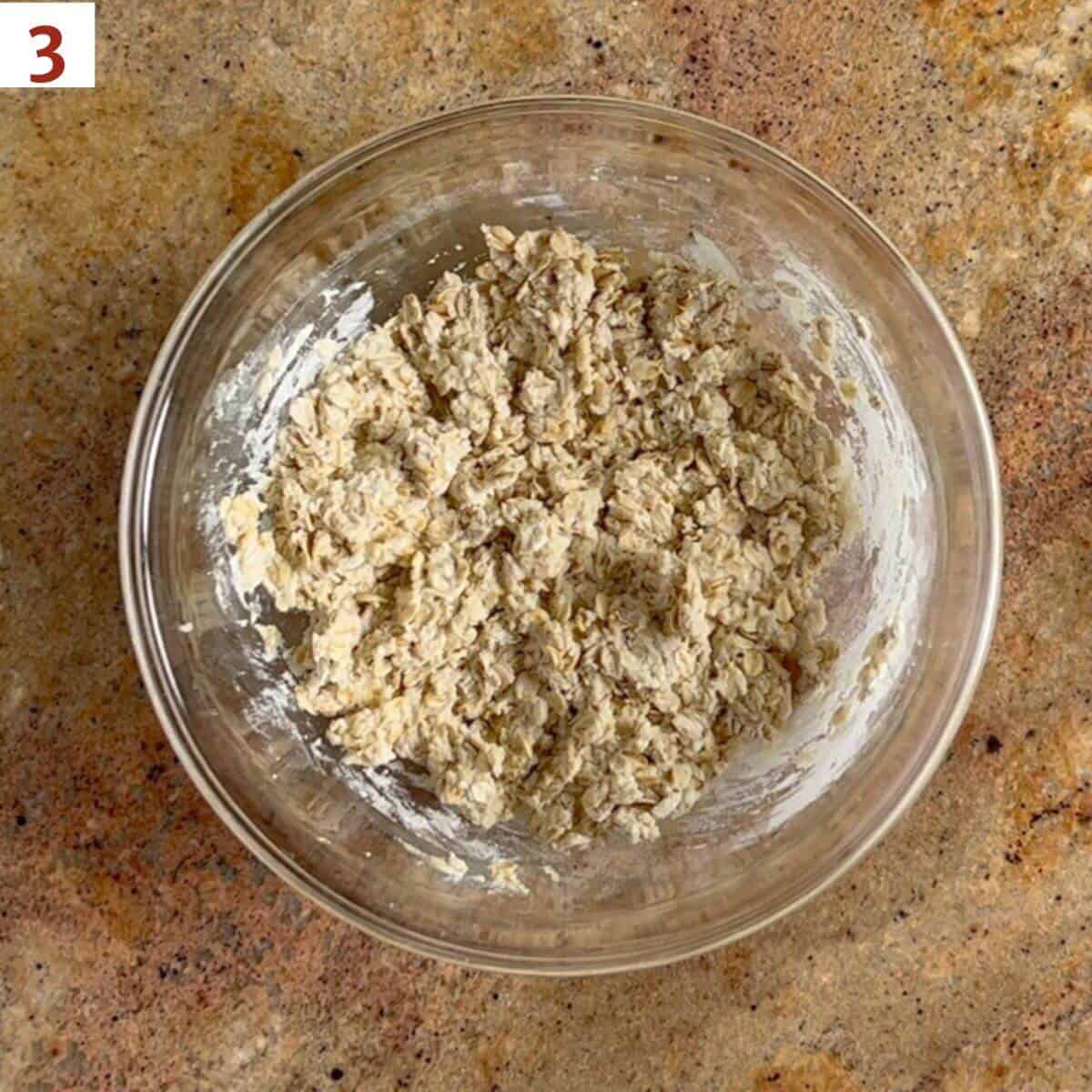
Step 2: Shape the bannocks
Transfer the dough onto a floured surface and roll it out to desired thickness, between ⅛ to ¼-inches (photo 4). Thicker bannocks will be chewier, while thinner bannocks will be crispier.
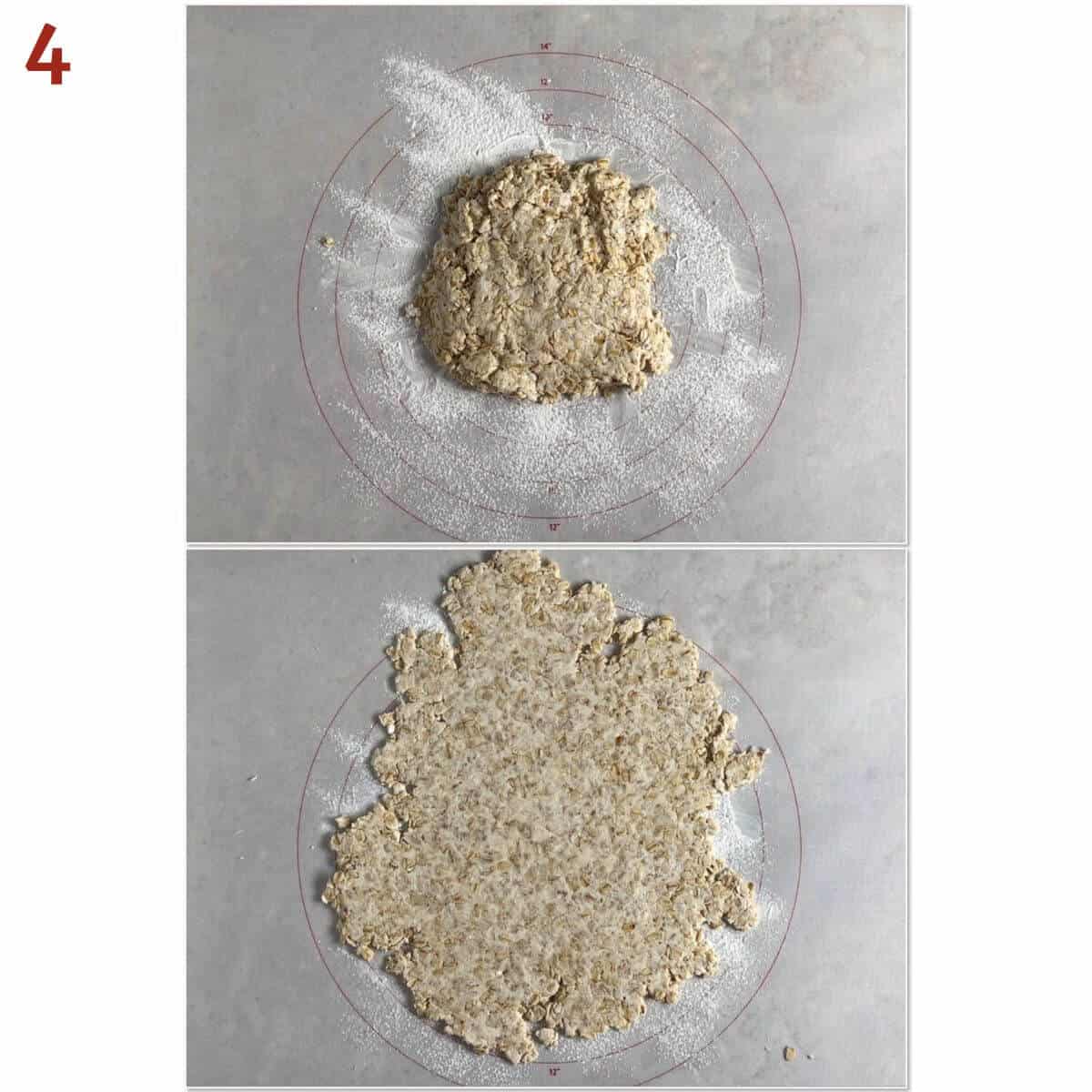
At this point you have a choice in how you shape the bannocks. Bannocks are usually round portions (or one large disk that's cut into wedges after cooking). I also like to cut rectangular portions that doesn't required re-rolling the dough. The choice is yours.
For round bannocks, use a 3-inch round cookie cutter, cut out rounds (photo 5). Gather the scraps, roll out again, and cut more rounds. Repeat until you've used up all the dough.
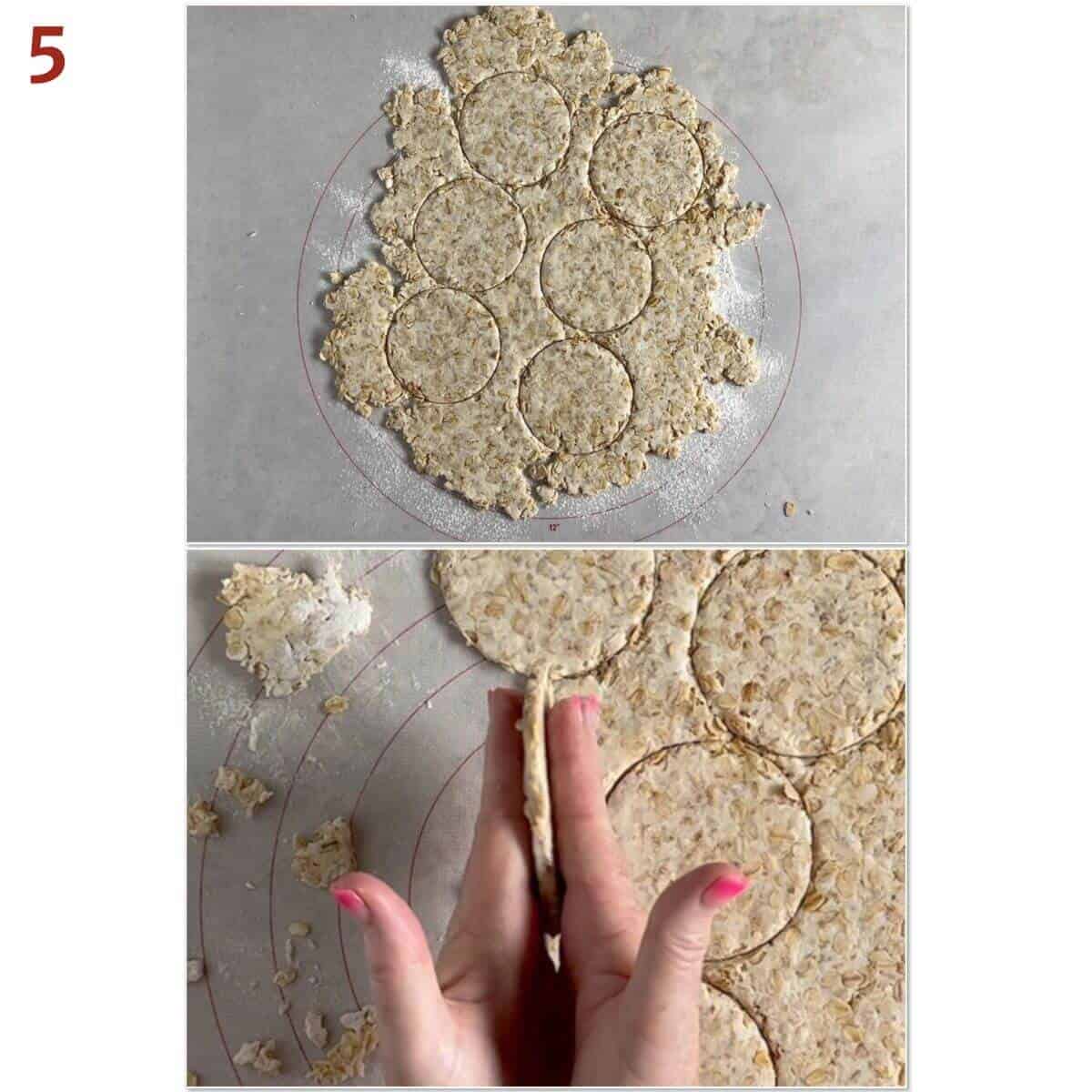
For rectangular bannocks, roll out the dough to form a rectangle. The size will depend on how thick you roll the dough (photo 6).

Slice the dough into rectangles with a bench scraper or knife to your preferred size (photo 7).

Step 3: Bake the bannocks
For this easy bannock recipe, the oatcakes are baked in the oven. See the FAQs for instructions for cooking them on a griddle.
Place the cut dough pieces on a half sheet baking pan that's lined with a Silpat silicone mat or parchment paper. Bake at 350˚F for 20 to 23 minutes, rotating the pan halfway through the baking time (photo 8).
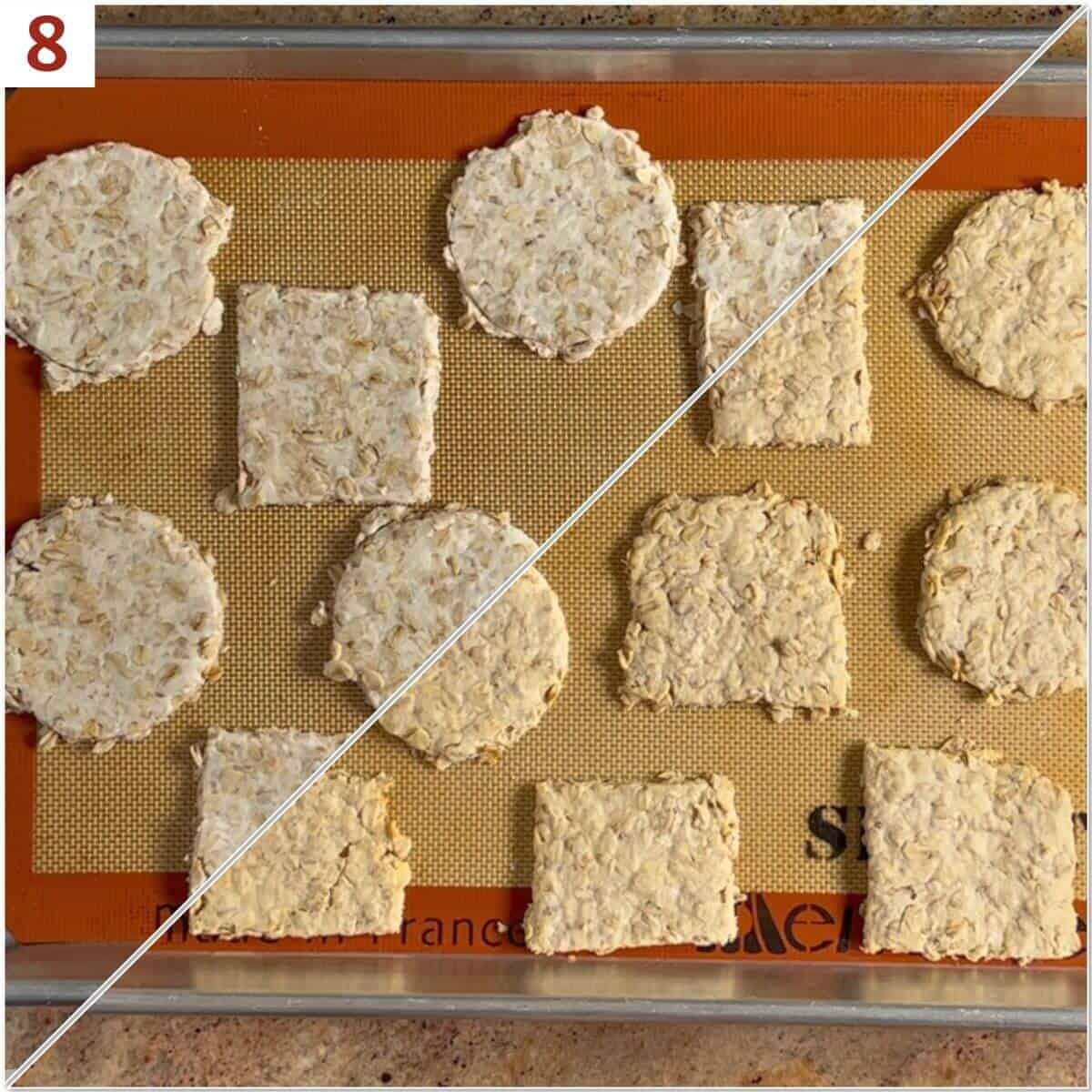
Remove to wire rack to cool (photo 9).
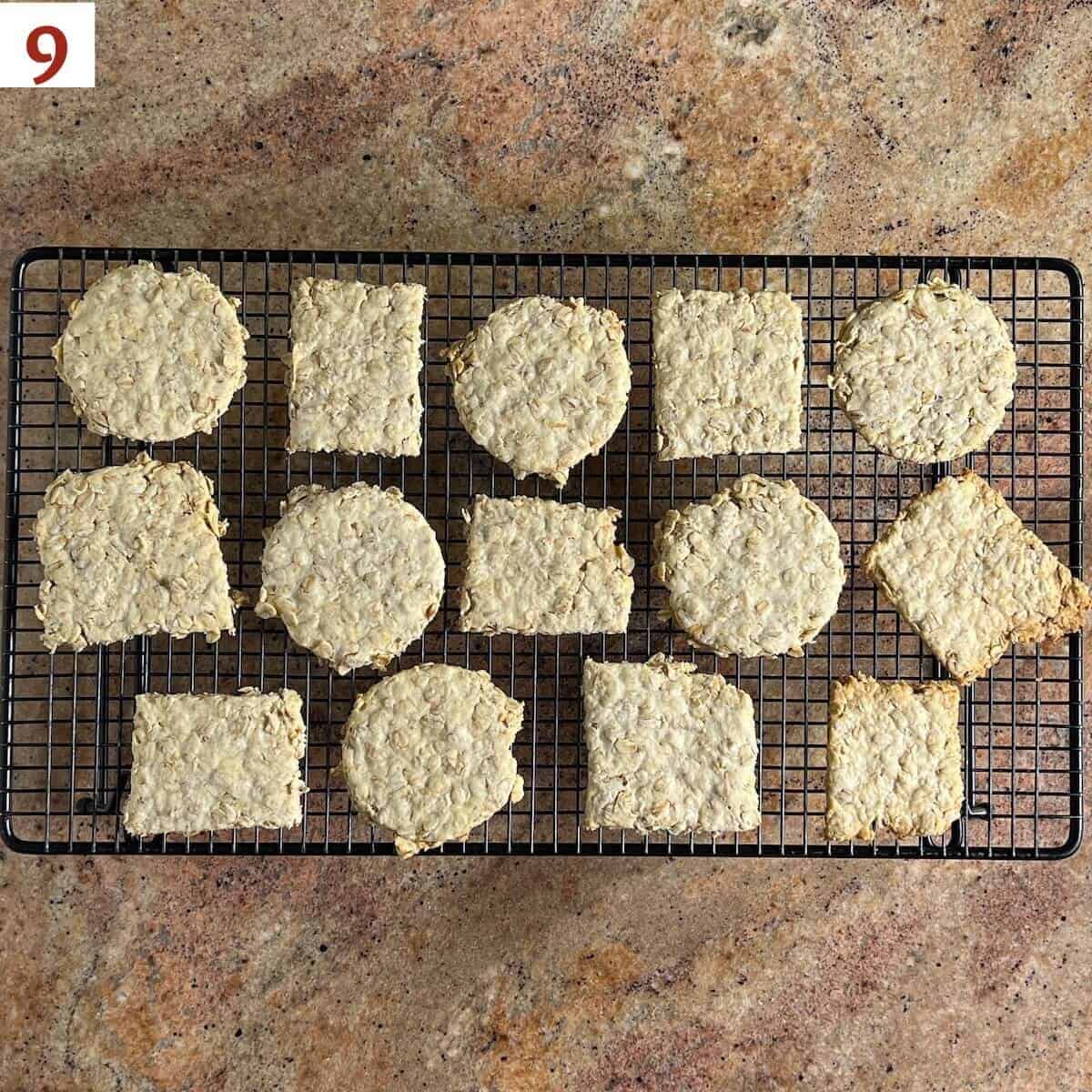
Storage instructions
Bannocks can be kept in an airtight container at room temperature for up to 3 days, or refrigerate for up to 5 days. They also keep well in the freezer stored in an airtight bag, and defrost on the counter for a few minutes before reheating (if desired).
Questions asked and answered
Here are some questions you might have...
Traditionally, bannocks were cooked over a fire on some sort of flat surface, like a griddle. Today, you'd preheat a pan (like a cast iron skillet) over medium-low heat for 5 minutes, then cook the dough on both sides until it's golden brown (between 5 to 10 minutes per side, depending on the thickness of the dough). The bannock can be one large disk that's cut into wedges after cooking, or you can make individual portions as described in the recipe.
There was a lot of discussion on that Outlander Facebook thread about how thick to roll out the bannocks. Some people said they should be thin and crispy, others thicker and chewier. There's no real consensus, so it comes down to your personal preference. I find that between ⅛ to ¼-inches is a good place to start.
Sure! If you maintain sourdough starter (like I do) and are always looking for ways to use your unfed sourdough starter (again, like I do), then bannocks are a great way to use the discard. Simply reduce the flour to ⅓ cup (45 grams), the salt to ½ teaspoon, and add in ⅔ cup unfed sourdough starter (150 grams). Omit the water entirely. Make the dough as directed, adding the sourdough starter with the melted butter.
Can you still call them bannocks if they're made with sourdough? I do, but I want to be culturally sensitive. Hopefully some nice person will let me know if that's ok (and send me a picture of a puppy. I love puppies!)
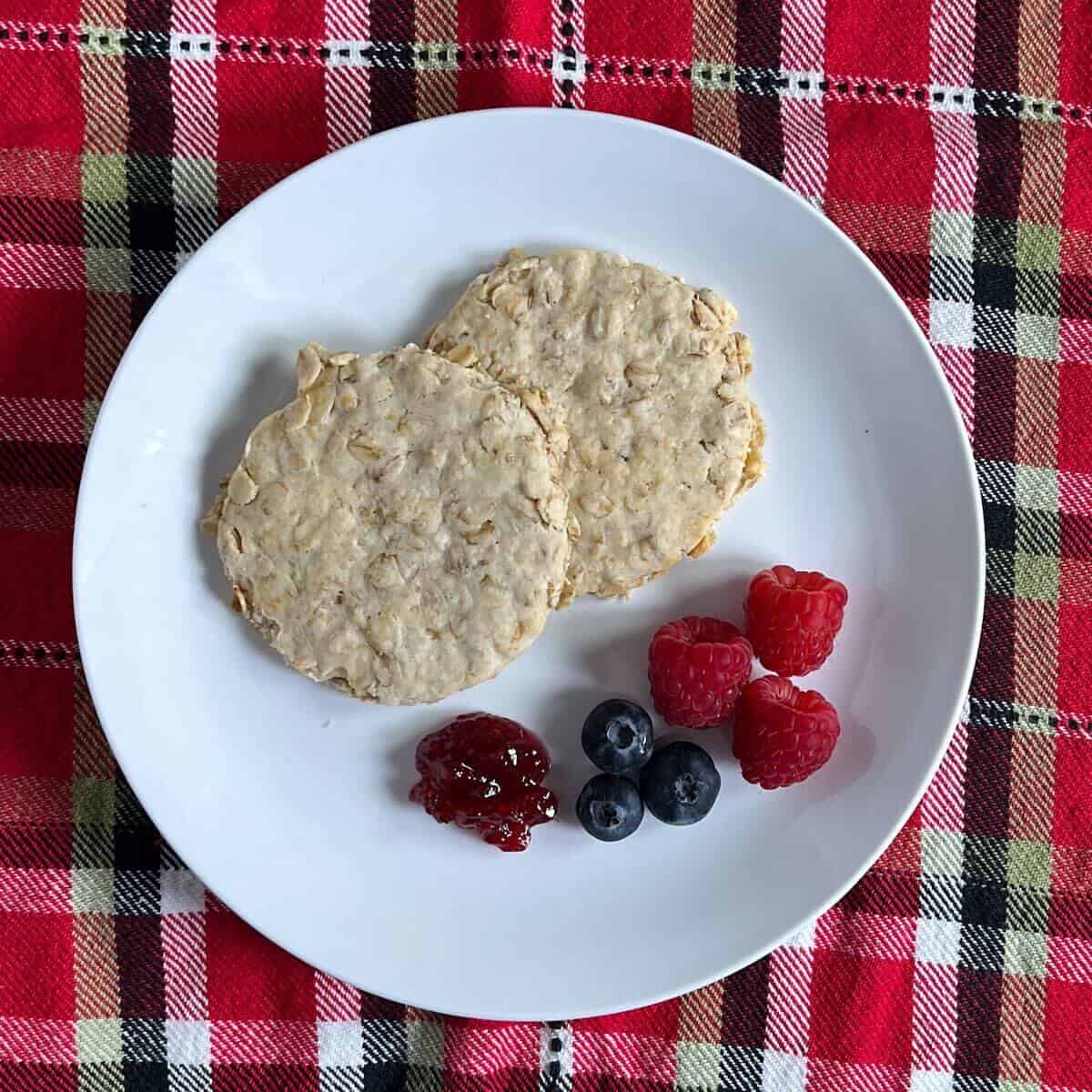

More recipes featuring sourdough discard to try
Recipe
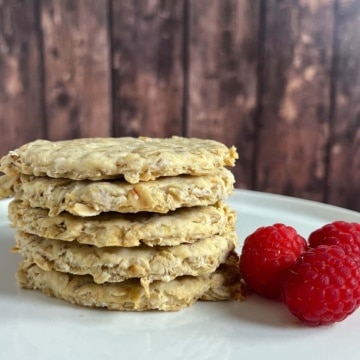
Scottish Bannocks (Scottish Oatcakes)
Equipment
Ingredients
- 1½ cups rolled oats, see Recipe Notes
- 1 cup all-purpose flour, see Recipe Notes for Sourdough Bannocks
- 2 teaspoons baking powder
- 1 teaspoon kosher salt, see Recipe Notes for Sourdough Bannocks
- 6 tablespoons unsalted butter, melted
- ⅓ cup water, see Recipe Notes for Sourdough Bannocks
Instructions
- Preheat oven to 350 °F. Line a half sheet baking pan with a Silpat silicone mat or parchment paper.
- In a large bowl, mix the oatmeal, flour, baking powder, and salt.
- Make a well in the dry ingredients, then pour in the melted butter and water. Stir well until a dough forms. Cover the bowl and let the dough rest for 10 minutes to soften the oats.
- Transfer the dough onto a floured surface and roll it out to desired thickness, between ⅛ to ¼-inches. Thicker bannocks will be chewier, while thinner bannocks will be crispier.
- For round bannocks: using a 3-inch round cookie cutter, cut out rounds. Gather the scraps, roll out again, and cut more rounds. Repeat until you've used up all the dough.
- For rectangular bannocks: Roll out the dough to form a rectangle (the size will depend on how thick you roll the dough). Slice the dough into rectangles with a bench scraper or knife to your preferred size.
- Continuing: Place the cut dough pieces on the prepared baking pan. Bake for 20 to 23 minutes, rotating the pan halfway through the baking time.
- Remove to wire rack to cool. Enjoy with sweet toppings like butter and jam, or savory toppings like blue cheese and smoked salmon.
- Storage instructions: Bannocks can be kept in an airtight container at room temperature for up to 3 days, or refrigerate for up to 5 days. They also keep well in the freezer stored in an airtight bag, and defrost on the counter for a few minutes before reheating (if desired).





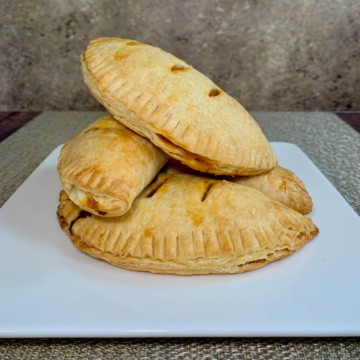




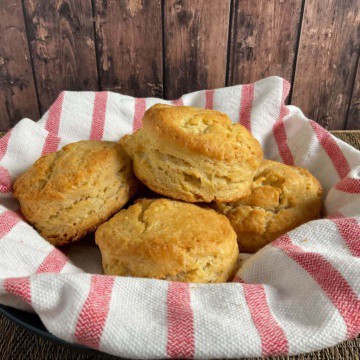
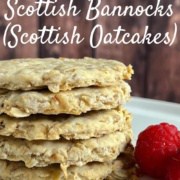

Wayne Downie says
This popped up when looking up recipes for a bannock - interesting recipe and i'm sure to give these a try!
However, as a Scot, Bannocks and Oatcakes are two entirely different beasts.
Bannocks are a griddle bread and more scone like in thickness - here's a wee comparison that might interest you from a Scots Bakery in Crieff: https://hamlynsoats.co.uk/recipes/outlander-inspired-oat-bannocks/
Would be good to see your take on this 🙂
Tammy Spencer says
Hi Wayne, Thanks for your perspective, and for a look at the version from the Crieff bakery. I've looked at many different recipes for bannocks, and they vary across the board in taste and texture. I haven't seen a distinction made between bannocks and oatcakes in my research, and for those of us outside the UK where bannocks aren't widely know, calling them oakcakes gives context. However, I respect your viewpoint and appreciate your sharing with us. Happy baking! 😉
Max Bacon says
Weights or volume would be more helpful than cupfuls . A very interesting recipe which I intend to do very soon , Many thanks.
Tammy Spencer says
Hi Max, you’ll find the weight measurements when you toggle between the US Customary and metric units (at the top of the ingredients list). Good luck, and happy baking!
Emily says
My question is: Can I omit or substitute the flour for a gluten free option? Can I use oat flour for the flour? I don’t require gluten free cooking for myself so am not as adept at it. But I do want to have the resources and answers so that I can cook for others who are. I am surprised that the “questions” section had questions that were already addressed thoroughly in the post.
Tammy Spencer says
Hi Emily, Thanks for the question. There are gluten-free flour mixtures that can be substituted 1 : 1 for the flour, like this one from King Arthur Baking. I think that just using oat flour (omitting the flour entirely) might not have the structure to hold the bannocks together, but I haven't tried it for myself. If you do try it, please let me know how it goes. Good luck, and happy baking! 😉
Carol says
Excellent and clear instructions.
Tammy Spencer says
Thanks, Carol! Enjoy 😉
Marcia says
I’m going to try these with the modification my grandmother of Scottish ancestry used. She called hers rolled oatmeal cookies - used her sourdough and added 1 tablespoon of granulated sugar. I’ll come back and tell you if that works.
Tammy Spencer says
Sounds good! Happy baking 🙂
Whatswhatlife says
Great easy recipe. I blitzed up some instant oats to make it a fine meal, rather than the whole rolled oats. They are a dry cracker great for soft cheeses. Thanks for sharing.
Tammy Spencer says
I’m glad you adapted the recipe to your liking 😉
Roh Shaw says
It's fine! You can do that. Frugality and thrift are traditional Scottish virtues after all. Now if you'll excuse me I'll grinding some oats into meal and grabbing some sourdough discard...
Tammy Spencer says
Love this! Happy baking! 😉
Teresa Harshbarger says
Loved your puppy comment! Made me LOL. Who doesn't love puppies.???? you have a wonderful blog!
Tammy says
Thanks, Theresa! 🙂
Lisa says
These are great! The sourdough version is perfect as I'm also always looking for something to do with the discard. I added some cinnamon and honey to the dough which brought it up a level. I will definitely be making these every time I make sourdough bread now!
scotchscones says
Hi Lisa, Cinnamon & honey? Great idea! I’ll have to try that also. Thanks for sharing 😉
Leslie says
ooooo That sounds amazing! how much cinnamon and honey should you add? I'm so new to this, I'm afraid to mess with the consistency too much in case I ruin the science-y things that happen when you bake!
chefkreso says
Tasty, lovely post!
Sarah says
I find your blog delightfully entertaining and informative. ....and thankfully grammatically correct and without misspellings. Thank you so much! Can't tell you how distracting it is to try to read blogs littered with errors of all sorts. Keep up the excellent work!
Tammy says
Thanks, Sarah! I'm glad you're joining me on the journey.